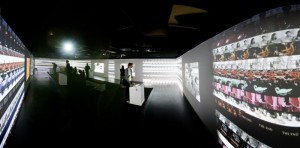
In late February, 2013, I had the pleasure of speaking with Simona Monizza, Curator at the EYE New Filmmuseum in Amsterdam, formerly known as the EYE Film Institute. The museum embraces, exhibits and teaches about film on multiple levels. It serves as a space with both permanent and rotating exhibits and there are film screenings daily. EYE is devoted to film archiving, restoration and collecting.
Although she has worked with EYE for over 13 years, Monizza’s role with the institute has changed somewhat over the years. After graduating from the Selznick School in Rochester, NY, she worked for one year with the British Film Institute and then moved to Amsterdam to work for the EYE Institute as a restorer. Working as a film restorer her duties were quite diverse. She was in charge of doing all of the prep work for multiple projects. This involved collecting any materials which might have information about a title, comparing different film elements, writing condition reports, deciding the best path to take for a particular project, working alongside the restorers at Haghefilm and overseeing quality control. As there was a flurry of projects going on at this time, she was often overseeing multiple film projects in various stages simultaneously. At this time, both Haghefilm and EYE were located in the same building. She said it was really great to be working side-by-side individuals in this amazing lab. There was one year in which they restored 400 films. Given the copious amount of time and energy it takes for just one film, this is truly astounding.

EYE has a large collection of silent, amateur, experimental, animation and mainstream films including the largest collection of Dutch films in the world. Each genre has its own Collection Specialist who works closely with that particular collection. EYE is continuing to add to their existing collection of 40,000 films, which Monizza is directly involved in. After working as a Collection Specialist, she is now the Curator of the Experimental Film Collection. For film, this involves preserving, collecting and cataloging. If there is a particular filmmaker whose films they want to have in their collection, she will actively go to them and try to get their material. This entails going to their house to check the condition of the film elements, creating an inventory and a contract. There have been many times when filmmakers don’t know where a lot of their elements are or their collections are very disorganized which only adds to the complexity of her role and tracking down crucial bits of information. At times there is a lot of sleuthing involved. Her focus however, is more on film collections not just individual titles. She said this is a very time consuming but exciting process because there are always new and interesting things to be discovered. Other times filmmakers approach her to see if their works can be taken in to EYE’s collection. In addition she develops programs at EYE to showcase these newly acquired films and finds ways to connect people to the exhibits. EYE also has a distribution branch which filmmakers can submit their films to. A jury watches these films once a month and can select titles they would like to integrate into their existing collections.
She discussed the difficulty in deciding what to digitize from their collection. “It’s not easy, some collections are easier to digitize than others” she stated, “and the experimental ones offer many challenges in this regard due to their material characteristics.” In order for films to be digitized, copies must be in good condition.
“The state of the film determines its preservation path. At the moment we still preserve on film but also digitize for access. Under access we understand many things, like making Digital Cinema Packages for distribution of short films, or giving online access to part of our collection through some websites.”
Many reversal prints need to be graded, which is another time consuming step that takes place in their lab. EYE is currently not able to scan nitrate or Super 8 films. As they are in many archives, things in the digital realm are progressing rapidly. Demand for immediate access is on the rise and EYE must try and keep up with people’s needs.
EYE receives roughly 80% of their funds from The Netherlands’ government. This contrasts largely to how archives are operated in the United States, which rely heavily on grant funding and donations for projects. In recent years however, not as much money has been devoted to restoration projects and more weight is being put on EYE to find their own funding sources.
Given that her background is in analog work, Monizza is not as excited about the future of digital worrying that it may replace analog completely.
“Both technologies are used in our restorations and the best results come from the combination of both, but it hurts to see so much knowledge and expertise on film disappear so quickly.”
As many individuals do, she feels that there is often more talk about what should be done about the death of film than there are actions being taken to prevent it. As her role has changed over the years and she has adapted, she is certain that she will continue to do so and carve out her own niche in the film world. Her last words of advice for anyone entering this field were to learn as much about the digital aspects of film preservation as possible, without forgetting what film is.
~Asia Harman
Leave a Reply